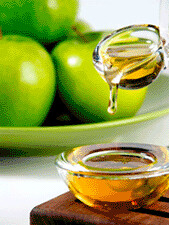Apples in Honey
While pomegranates are evocative and sensual to eat, their scent is not the most fascinating part about them. The scent that I have tried that included pomegranate neither authentic nor interesting – and for the most part brought a berry-like interpretation of the fruit (Quel Amour!, Samsara Shine, Euphoria, Pomegranate Noir). Therefore, in salute to the Jewish holiday season, I have decided to dedicate a few entries to Apple in Honey – a symbolic food that signifies wishes for a sweet and whole year (as round as the apples dipped in the honey). You should try that too – it’s delicious!
First let’s talk a bit about the roles of honey and apples notes in perfumes. Apple and honey notes are usually used separately in perfumes, and add completely different qualities to a scent. An apple a day may keep the doctor away, but when it comes to perfume, there are no real apples used – it’s always synthetic molecules that resembles the idea of an apple, rather than a true fresh apple. Some natural perfumers may use tinctured apples or apple essence, but these smell like dry apples and from my experience are very unnoticeable in the presence of the far more concentrated essential oils and absolutes. The closest you can get to apple with naturals, so far, is Roman Chamomile essential oil, which has an intense, sweet, golden-delicious like apple notes. Apple simulations in most perfumes add a crisp, tart, slightly sweet top note that gives an olfactory impression of just biting into an apple (and perhaps getting some of the juice going up your nose by mistake!). You will mostly find apples in floral composition from the fruity category (i.e.: Spring Flower, Baby Doll), and occasionally from the marine category (Light Blue). Since I have already reviewed my favourite apple scented perfume, Spring Flower, I will dedicate a full review this week to another (surprise) apple scent of my choice, so stay tuned!
Honey, on the other hand, is very similar to the actual tangible real-life product we know as either honey, honey comb or beeswax. Just imagine these notes condensed into the richest, most sticky and syrupy concoction, so concentrated that some animalic civet-like notes are swirling at the bottom and threatening to take over with their indolic affection. Honey is used for both its qualities: gourmand and animalic. Therefore it is most often found in oriental perfumes. As in my grandmother's honeycake, honey absolute goes particularly well with cloves. Therefore, it is not uncommon to find honey in heavily spicy compositions (Black Cashmere, Asja, Epice Sauvage) , as well as rich, thick, sweet gourmands (Finjan, Angel, Black Licorice, Miel de Bois) and ambery orientals (Fumerie Turque). Occasionally, honey will even find its way into more subdued florals (White Linen, Zohar).
Another beautiful thing about honey is that it smells and tastes differently depending on which flowers the bees were collecting their pollen and nectar. Therefore there are also variations in honey absolute: there is rich honey absolute (as from the honey collected from wild flowers and thorny bushes), and there is light citrus honey (as the one used in l’Instant de Guerlain and many scents in the Serge Lutens line).
So dip your crisp, freshly harvested in honey, and tell me of your favourite honey and/or apple scented perfumes!

